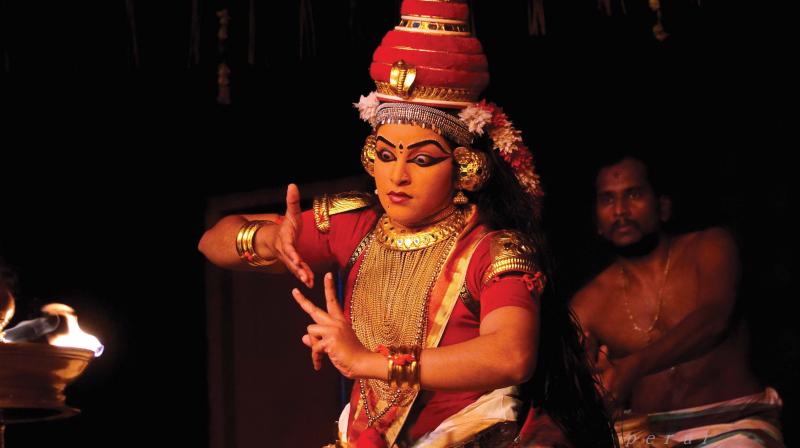Keeping Koodiyattam alive

Every state in India boasts of art forms that are unique and part of its heritage. Any
exponent of those art forms is duty-bound to pass them on to the generations to come. Koodiyattam artiste and guru Kalamandalam Sangeetha is one of the youngest exponents of the art form which is 2,000 years old. She is a proud torchbearer of the temple art. As an artiste and a teacher at a prestigious institution like Kerala Kalamandalam, she believes she has the responsibility to popularise it even more across the globe.
“It is a challenging task to keep the art form alive and relevant. Compared to many other art forms, temple arts are ignored by many for no reason. The effort and the dedication that we put in are being wasted and modern art forms are getting all the attention. It is indeed painful to see a cine artiste or a cinematic dancer gets all the applause at a cultural event and temple arts being performed in front of a thin audience. We feel our efforts go in vain. So, the first priority is to make temple arts more popular,” says Sangeetha, who is an exponent of nangiarkoothu, too.
People have a lot of misconceptions about koodiyattam and nangiarkoothu says Sangeetha. “The first one is that koodiyattam is not for everyone. The art form itself demands a certain level of knowledge before-hand, like kathakali. This is one of the main reasons why the art is still watched by a particular set of audience. But before every performance, the artiste would conduct a small session that would explain what is going to be performed in front of them and what is the story. This helps the audience get an idea about the performance beforehand.” But according to her, the popularity of koodiyattam and nangiarkoothu is rising and they are performed at a host of cultural events.
Sangeetha, who teaches at Kerala Kalamandalam, thinks there is a huge fall in the number of students who wish to learn these age-old art forms. “Let it be any art form, here in Kalamandalam, the number of new students joining to learn them is very small. The level of dedication and the commitment towards the art should be exemplary if you want to master it. But the current generation
wants everything very fast. Koodiyattam is known for its elaborate costumes, dramatic make-up and highly stylised abhinaya or facial expressions and gestures. Mastering this traditional Kerala classical theatre style is no easy task it involves years of physical training and lessons in the ancient language of Sanskrit. Mastering it isn’t that easy. Results won’t come easy. That really pulls the kids back from learning it,” says Sangeetha. Also students are now joining the institution only with the aim of participating in competitions; thus the gurukala way, the way in which artistes used to learn, has gradually vanished.
Sangeetha made headlines when she staged a nangiarkoothu performance called
Krishnacharitha, the life of Lord Krishna, through 271 shlokas. That programme held at Angadippuram in Malappuram district was the first ever nangiarkoothu performance staged outside temple premises in the Malabar region. “It was a great experience and I felt happier because my intention was to make the common people aware of the art form rather than just performing what I know,” says Sangeetha, who is also adept in classical dance.
She has performed at numerous stages and has been part of famous cultural festivals across India and abroad. Those include a performance at the Malta Trade festival in 2009 and a koodiyattam performance conducted by Mudra Cultural society, Singapore, in 2012.
More than teaching what she has mastered, she wishes to be a performer. “I love teaching
students but as a performing artiste, I would like to go places and perform. I want to keep the art form alive and make it more popular. I have a responsibility to do that. But for an artiste like me, teaching is just another way of backing myself financially, because the life of an artiste cannot sustain just through stage performances. The situation demands that we have a backup plan. But my priority will always be performing,” she concludes.

